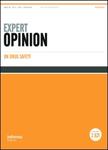版权所有:内蒙古大学图书馆 技术提供:维普资讯• 智图
内蒙古自治区呼和浩特市赛罕区大学西街235号 邮编: 010021

作者机构:154 rue de la Glacière 75013 Paris France +33 1 43 37 58 97 iciliocavero@***
出 版 物:《EXPERT OPINION ON DRUG SAFETY》 (药物安全性专家评论)
年 卷 期:2015年第14卷第6期
页 面:999-1008页
核心收录:
学科分类:1007[医学-药学(可授医学、理学学位)] 10[医学]
主 题:anticancer drugs CiPA concordance analysis emesis high-level CNS functions nausea peripheral neuropathy safety pharmacology video-tracking analysis visual functions zebrafish swimming
摘 要:Introduction: The Annual Meeting of the Safety Pharmacology (SP) Society is a yearly event designed to keep attendees abreast of how to best identify and mitigate organ function liabilities of candidate drugs selected for clinical assessment. Areas covered: Heart rate (HR) and blood pressure (BP) effects of candidate drugs in dogs/monkeys have satisfactory human translation. Mechanism-designed assays offer opportunities for innovative approaches to identify chemotherapeutic-induced peripheral neuropathy (PN). SP has a large array of methodologies to determine safety on eye functions. Video-tracking analysis of zebrafish swimming behavior accurately profiles drugs for high-level brain function liabilities. Available in vitro and in vivo assays can identify, and determine physiological and pharmacological mechanisms of, candidate drug-induced emesis. Ad hoc Working Groups have already finalized protocols for testing the comprehensive in vitro arrhythmia assay (CiPA), an innovative paradigm for assessing mechanisms conferring candidate drug proarrhythmic liabilities. Expert opinion: The good concordance of non-clinical and clinical Phase I BP and HR effects of candidate drugs support the use of dog/monkey models for clinical outcome. Drug liabilities (e.g., PN, nausea, vomiting, etc.) affecting non-vital organs/systems require the same degree of SP attention given to vital functions as they can dramatically reduce patient quality of life.